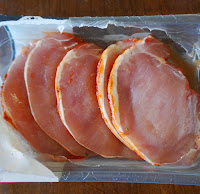Pobre de mí! Poor me, the party has ended. That was the lament of thousands of Pamploneses (the inhabitants of Pamplona, Navarra) at midnight July 14 signaling the end of the Fiesta of San Fermín. Time to fold up the red bandanas until next year.
You don’t have to run with the bulls or party until the wee hours to enjoy some of the gastronomic treats of the san fermines. This dish of ham (or pork) slices smothered in fresh tomato sauce is a summertime treat no matter where you are. Typically, the dish is eaten as a snack after the afternoon bullfights to fortify the body for a night’s partying. You could serve it for dinner anytime.
 |
| Fried ham slices are smothered in tomato sauce. |
 |
| Store-bought marinated pork loin instead of ham. |
 |
| The magras (slices of ham or pork) are traditionally served with a fried egg and croutons. Fiesta fortification. |
Ham with Tomato Sauce
Magras con Tomate
Magras means “lean meat”. As made in Navarra, this dish calls for ¼ -inch-thick slices of serrano ham. The ham, probably from nearby Teruel, should not be overly cured. If it is very cured, the slices are soaked in milk to remove excess salt and soften the meat.
I adapted the recipe to use store-bought lomo adobado, pork loin that has been lightly cured with salt, garlic, and spices. I think Canadian bacon would be an excellent substitute for Navarra-style ham. Which ever you use, the meat needs only vuelta y vuelta, flip it once and out, less than a minute per side.
The fresh tomato sauce can be made in advance, if desired. If tomatoes are plentiful, made double the recipe and keep for other uses.
 |
| Fresh tomatoes for sauce. |
Serves 4.
For the tomato sauce:
2 pounds ripe tomatoes
¼ cup olive oil
1 ½ cups chopped onion
3 cloves chopped garlic
1 bay leaf
1 tablespoon chopped parsley
1 teaspoon salt
Freshly ground black pepper
 |
| Lightly cured pork loin. |
For the ham:
8 slices (¼ -inch thick) Canadian bacon, ham, or lomo adobado (1 pound)
Olive oil
To finish the plate:
Olive oil for frying
6 cloves garlic, not peeled
4 eggs
Croutons of fried bread
Fried ham
Tomato sauce
Chopped parsley
Remove stems and cores from tomatoes and chop them roughly (makes 4 ½ -5 cups). Place in a blender or food processor and grind. Push the juice and pulp through a sieve. Discard the remaining solids, containing seeds and bits of skin.
 |
| Make tomato sauce. |
Heat the oil on medium in a large saucepan. Sauté the onion and garlic until softened, 10 minutes. If onion begins to brown, add a spoonful of water and continue frying. Add the tomato pulp and juice to the pan. Season with bay leaf, 1 tablespoon parsley, salt, and pepper. Cook on medium heat until the sauce is thickened, 15 to 20 minutes. If the sauce tends to splatter, partially cover the pan.
Discard the bay leaf. Puree the sauce in a blender or food processor until very smooth. Store the sauce covered and refrigerated until ready to use. (Makes about 1 ¾ cups sieved sauce.)
Lightly oil a heavy skillet and heat on medium-high. Fry the slices of bacon, ham, or lomo until lightly browned on both sides, 30-60 seconds per side. Remove.
Add oil to the skillet to cover the bottom to a depth of ¼ inch. Heat on medium-high. Lightly crush the garlic cloves and add them to the skillet. Break the eggs into the skillet. Scatter croutons around the eggs. Fry until the whites are set but yolks still runny.
Place 2 slices of fried ham on each plate. Heat the tomato sauce. Spread sauce over the slices of ham and sprinkle with chopped parsley. Place a fried egg, fried garlic, and croutons alongside. Serve the plates.
*** *** ***
Also this past week was the Fiesta de la Virgen de Carmen. This virgin is the patron saint of sailors and is celebrated in many coastal communities of Spain. It’s the occasion to dine on seafood stews.
Upcoming festivities: Feria de Málaga, August 17-23.
*** *** ***
An Andalusian version of Pork with Tomato Sauce (Magro con Tomate).
How to make croutons of fried bread.
Kalimotxo (the favored drink for San Fermín) and more fiesta drinks.
*** *** ***
FLAVORS OF AL-ANDALUS, The Culinary Legacy of Spain, will be published August 12, 2025! See Meatballs with Backstory for more about what’s in the book and to view several of the page spreads. See advance reviews at Advance Praise for Flavors of al-Andalus.
This cookbook explores the fascinating story of the deep and lasting influences that Islamic culture has left on modern Spanish cooking.
Author and Spanish cooking expert Janet Mendel tells the story of the Moorish influence on Spanish cooking through 120 recipes and photographs for modern-day dishes, from salads and vegetables to fish, poultry and meat to sweets and pastries, that trace their heritage to foods served in medieval times. Dishes from this era include exotic spices such as saffron, the use of fruits and almonds with savory dishes, and honeyed sweets and pastries. The flavors of al-Andalus live on in modern Spanish cooking and are what makes Spain’s cuisine distinctive from the rest of Europe. (Hippocrene Books)
***























